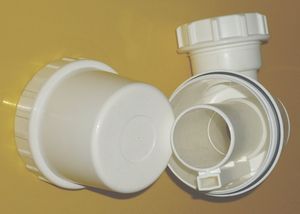Noisy Pipes
There are 3 different types of pipework noise:
- waterhammer (foghorn like noise or hammering sound)
- hiss
- expansion noises (occasional clunks)
Each has different causes and different solutions.
Waterhammer
Waterhammer is resonance of the water column inside the pipe. This can happen at low frequency, causing a hammering sound, or at auidible frequency, making foghorn-like noise. It can be very loud!
Solutions
The usual cause is a rubber disc in a tap or fill valve oscillating. The solution is to renew the rubber washer/diaphragm.
Turning down the flow rate also usually works. Usually this gives an acceptable flow rate, sometimes not.
Installing damping on the pipework can also often work, but the forces involved in waterhammer are high and the damping needs to be a lot more effective than just lagging. One sometimes effective approach is to jam a block of damping material between the pipe and wall in roughly the half way point between 2 pipe clips. Do this in a few locations. The material can be expanded polystyrene, solid rubber or folded cardboard, and needs to be inserted fairly firmly to be effective.
Other options
Where the above don't work or can't practically be done, there are other ways to reduce the factors that cause the problems. But none of these have a large effect, so don't always work. Most work by introducing greater damping to the pipework.
Wrap the pipe with lagging.
Box the pipes in. This provides a physical barrier to sound transmission, and creates a void that can be filled with rockwool or similar for damping and sound absorption. The heavier and stiffer the boxing, the more effective it is. Minimise and fill any gaps for best performance.
Lag the noisy pipe wherever it goes outside of where it is causing the noise problem. Eg lagging added in the loft will have some benefit on downstairs noise too.
For pipe under floorboards, place a few layers of carpet offcuts onto the pipe and put the boards back. Carpet damps pipe movement. The carpet should be wide enough to droop down onto the ceiling either side of the pipe. Not recommended for incoming cold pipes due to possible condensation.
Place a weight on the pipe on every other section of pipe run (ie between pipe clips 1&2, 3&4 etc). This changes the resonant frequency of different pipe sections, reducing overall Q.
A flexible pipe section sometimes cures water hammer.
Water hammer arrestors can be added to plumbing at the source of the problem.
Air pockets can help absorb vibration. These are added by using a tee instead of an elbow, and capping the upward pointing new section of pipe. The upright fills with air or dissolved gases from the water, acting like an electrical capacitor.
Hiss
Hiss is caused by very fast water flow rate in a pipe, or by high speed water escape. Hiss is prevented by using larger bore pipe or turning down flow rate.
Other ways to treat hiss include:
- lagging pipes
- using plastic rather than metal pipe
- using larger bore pipe
- using swept corners instead of sharp corners
- fixing pipe clips to rigid surfaces rather than plasterboard, which acts like a sounding board.
- fitting a valve in the affected circuit, or each circuit during initial installation
- boxing pipes in, filling the box void with heavy insulating material
- if pipe must be clipped to a stud wall, implement noise reducing damping measures in the wall itself.
Clunking
Occasional clunks and bangs are caused by copper pipe expanding and contracting when heated and cooled. When the pipe's rigidly fixed, due to its inherent springiness it builds up force until it slips in its fixings, creating a clunk. It's mainly an issue for kids who get scared, and situations requiring complete silence such as recording studios.
Prevention
- Loosen pipe clips slightly where possible
- or replace with clips that can be loosened
- Plastic plumbing doesn't suffer this issue
Sound reduction
- Fix pipes to rigid walls, not plasterboard
- Box & insulate pipes
- lag pipes
- use plastic pipe
Gurgling Sinks
Air being sucked into the waste pie through the sink trap causes gurgling. One option is to fit an antisyphon trap, which has a second extra tube next to the main outlet. As you can see its simple to convert a standard bottle trap to an antisyphon type. Waterless traps are another option.
Caution
Be cautious about using expanding foam as a damping material, some types expand with huge force after they've solidified and can cause considerable damage.
